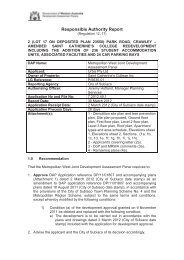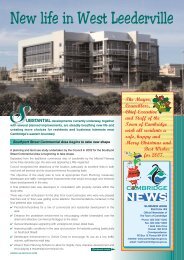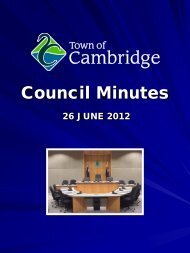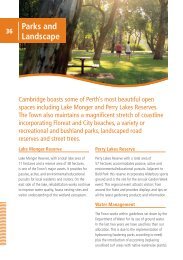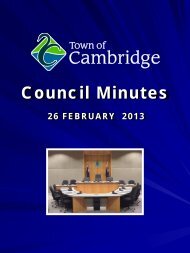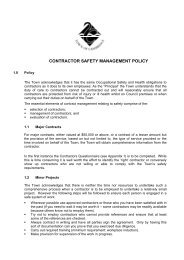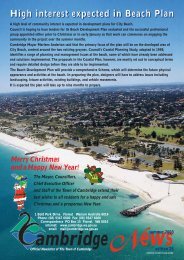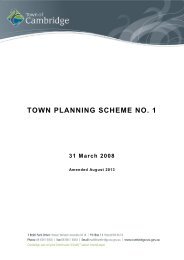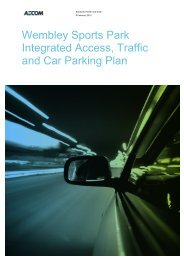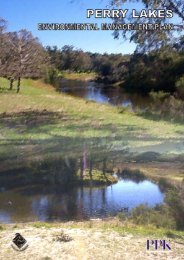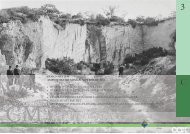Council Minutes - Town of Cambridge
Council Minutes - Town of Cambridge
Council Minutes - Town of Cambridge
Create successful ePaper yourself
Turn your PDF publications into a flip-book with our unique Google optimized e-Paper software.
COUNCIL MINUTES<br />
TUESDAY 20 DECEMBER 2011<br />
The main components <strong>of</strong> this strategy are:-<br />
<br />
Distributor Roads - Total length 45.5 kilometres which includes 7.6 kilometres <strong>of</strong> dual<br />
carriageway and traffic volume greater than 2,000 vehicles per day. Most will qualify for<br />
MRRG grants depending on condition. Resurfacing is scheduled at a surface age <strong>of</strong> 20<br />
years. This means that an average <strong>of</strong> 2.3 kilometres per year will require resurfacing. In<br />
practice, distributor roads have required resurfacing at a seal age between 15 and 25<br />
years in the <strong>Town</strong>.<br />
Local Access Roads - Total length 121 kilometres. Traffic volume less than 2,000<br />
vehicles per day. Resurfacing is scheduled every 30 years depending on condition. This<br />
means that an average <strong>of</strong> 4 kilometres per year will require resurfacing. In practice, local<br />
access roads have required resurfacing at a seal age between 25 and 35 years in the<br />
<strong>Town</strong>.<br />
<br />
Condition <strong>of</strong> Precast Kerb - If short sections <strong>of</strong> precast kerb are misaligned then work is<br />
programmed to re-lay these sections. If long sections <strong>of</strong> kerb are deteriorated or are too<br />
low, then they are replaced with extruded kerb. This has been done on a large scale, for<br />
example on Oceanic Drive, Challenger Parade and The Boulevard Service Road. The<br />
need for kerb replacement will increase over the next 20 years as the precast-kerbs<br />
reach the end <strong>of</strong> their useful lives. The replacement <strong>of</strong> kerb is a substantial item in this<br />
asset management strategy. At present, the replacement <strong>of</strong> kerb is deferred until it has<br />
become necessary due to a serious lack <strong>of</strong> kerb height or a significant number <strong>of</strong> kerb<br />
sections are broken or misaligned. The average value <strong>of</strong> kerb replacement currently<br />
ranges from $0 to approximately $160,000 each year. The report recommends that the<br />
<strong>Town</strong> considers replacing more kerbing to improve the cosmetic appearance <strong>of</strong> streets<br />
and construction standards. If kerb is not replaced at this opportunity, then it has to be<br />
good enough to last until the road is next resurfaced in 20-30 years time.<br />
Lanes - Traffic volume less than 200 vehicles per day. Total length 21 kilometres (14<br />
kilometres sealed). Schedule resurfacing every 30 years depending on condition. Two <strong>of</strong><br />
the older lanes have been resurfaced in the last 10 years and more will be required in<br />
future years.<br />
Laneways will need to be added to the road resurfacing program as their seal age<br />
reaches 30 years. It is anticipated that funding <strong>of</strong> $65,000 per year will be required for<br />
resurfacing all 21 kilometres <strong>of</strong> lanes. This should coincide with the completion <strong>of</strong> the<br />
current lane upgrading program in approximately 10 years time that currently has funding<br />
<strong>of</strong> $300,000 per year.<br />
<br />
Condition <strong>of</strong> the Asphalt Seal - The condition <strong>of</strong> the asphalt is determined visually and<br />
a rating is given for asphalt type, surface defects, extent <strong>of</strong> patching, cracking, rutting and<br />
bitumen binder condition. The condition <strong>of</strong> the asphalt at the time <strong>of</strong> inspection will<br />
depend on its age, the original standard <strong>of</strong> road construction, type <strong>of</strong> sprayed seal or<br />
asphalt used for the wearing surface and traffic loading. As asphalt seals age, the<br />
cracking, rutting, defects, and binder condition all get progressively worse until one <strong>of</strong><br />
them reaches an intervention level that dictates that the road must be resurfaced. These<br />
values are then assessed by a computer program to rank each section <strong>of</strong> road into a 20<br />
year program. The computer program uses a deterioration algorithm that predicts when<br />
each section <strong>of</strong> road requires resurfacing. The current standard road asset management<br />
computer s<strong>of</strong>tware is ROMAN II and is currently supported by WALGA.<br />
H:\CEO\GOV\COUNCIL MINUTES\11 MINUTES\DECEMBER 2011\C CR.DOCX 145



